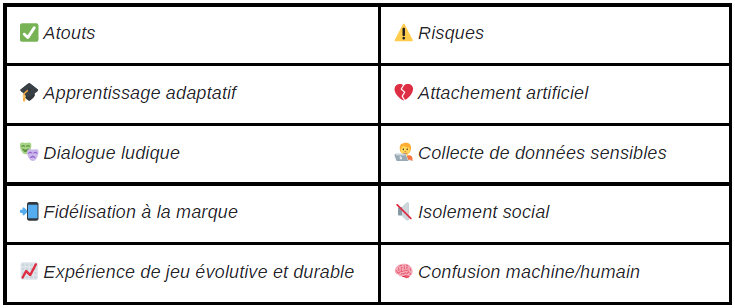Thursday, July 24, 2025
When AI Comes to Toys: Magical Innovation or a Double-Edged Sword?
Action figures & accessoriesGaming & Pop cultureElectronics & Robotics

Artificial intelligence (AI) is redefining gaming.
In 2025, children's bedrooms will be home to emotional robots, connected stuffed animals, and soon dolls capable of conversing with their owners.
The promises are seductive: Personalization, learning, emotional connection... but the rise of these smart toys also raises fundamental questions for professionals in the sector.
Between market opportunities and educational responsibility, where should we place the cursor?
🧸 The new generation Furby: Cuteness under control
Furby is back in force in 2023!
Hasbro is tapping into nostalgia and relaunching its iconic animated plush toy with a technological update—more than 600 phrases, voice interaction, LED ears— but without internet.
A decision taken after past controversies.
📍Quick reminder: in 1999, the NSA banned the Furby from its premises, fearing that it would record conversations.
Now, some hackers are going further, grafting ChatGPT into the plush toy, to make it a chatty and (sometimes) slightly creepy assistant.
🎭 This case study raises a central question: Can the illusion of life in an object be without consequences for a child?
🤖 Ropet and the “doudous 3.0” generation
At CES 2025, the spotlight was on Ropet, an interactive emotional robot.
Equipped with sensory and facial recognition capabilities, it adapts its responses to the user's emotions. With a voice optionally animated by ChatGPT, Ropet is a new digital companion, more emotional than educational.
This type of robot meets a growing need: Combating loneliness, creating connections without constraints.
The global market for companion robots, estimated at $10.5 billion in 2023, could quadruple by 2029 (Mordor Intelligence).
But is this "artificial companion" harmless? Psychologists warn of the risk of simulated attachment, or even emotional confusion, especially among young people.
💬 Mattel x OpenAI: When Barbie starts talking (for real)
In June 2025, technology giant Mattel announced a strategic partnership with OpenAI, creator of ChatGPT. The goal? To inject generative AI into future Mattel-branded toys.
Voice assistants inspired by Barbie, Polly Pocket, and Hot Wheels are in development. The first product is expected in late 2025. Josh Silverman, Chief Franchise Officer, says: “This incredible technology will allow us to reinvent the future of play.” (Source: Business Wire) Unlike Hello Barbie (2015), Mattel assures that privacy, security, and data control will be pillars of this development.
📚 Smart Toys = Personalized Learning?
AI is not limited to emotional interaction. It also enables:
- To adapt the level of play to the child's age or progress (logic, calculation, languages, etc.),
- To stimulate curiosity with voice quizzes or interactive scenarios,
- To encourage creativity through open generative responses (e.g., “Invent a story with tondragon”).
These uses carry educational value, particularly in the context of Learning Through Play, widely promoted by the LEGO Foundation and the OECD. But vigilance remains necessary because can a voice assistant replace a parent, an educator, or a friend? And above all, does the child understand that they are talking to a machine?
⚖️ Summary table: AI and toys, a balance to be found

🛡️ What regulations for these toys of the future?
Europe is taking the lead. The AI Act, adopted in 2024, classifies AI toys as high-risk systems. By 2027, these products will have to demonstrate:
- Transparency (the child must know that he is talking to a machine)
- Data security
- Human supervision
- Absence of emotional or commercial exploitation.
🎯 At the same time, the CNIL (in France) reminds us that all connected toys must comply with the GDPR, particularly with regard to the protection of minors' data.
🧩 And for manufacturers? A triple responsibility
Integrating AI into a toy is not something you can improvise. It requires:
- Design ethically: From the R&D phase, think about emotional impact and bias.
- Secure: Encrypt data, prevent unwanted eavesdropping.
- Explain: Support families in their use, and train points of sale to talk about it.
For toy companies, AI represents an acceleration of the innovation cycle. In the midst of competition with apps and screens, offering an evolving, interactive, and connected toy can appeal to both children... and parents. But the toy must not become an assistant, a babysitter, or a sales tool. It must remain a space for play, surprise, and freedom.
📚 Sources cited:
Hasbro / Furby – BFMTV Mattel x OpenAI – Business Wire Ropet – Engadget CES 2025
Robot market – Mordor Intelligence AI Act – European Commission Connected toys – CNIL
Attachment to AI – MIT / Sherry Turkle Val d'Europe Infos – Post on Ropet & Labubu⚖️ Summary table: AI and toys, a balance to be found
Content provided by Yoganoël